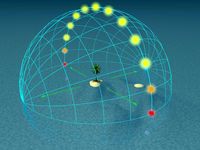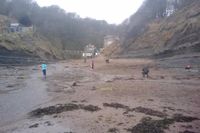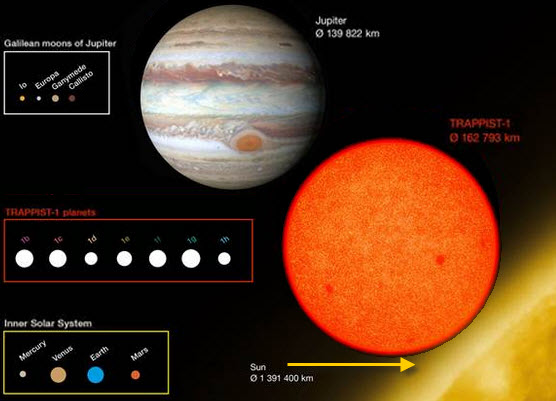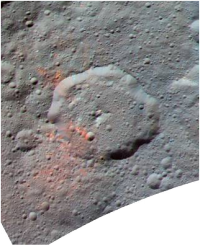Welcome to the WDAS monthly newsletter for March 2017: a digest of the month's latest contributions to our website. Below you'll find Society News, Sky Notes and In-Focus articles printed in full. There's also future events, and trailers for other articles which appear in full on the website - just a click away!
On the website you'll also be able to comment on articles, and if you'd like to play an editorial role in creating new content, just let us know!
Society News
 The date of the Vernal Equinox and officially the start spring in the northern hemisphere falls on March 20th this year. This is when the Sun's path - the ecliptic - first crosses the celestial equator on its apparent journey northwards into the sky.
The date of the Vernal Equinox and officially the start spring in the northern hemisphere falls on March 20th this year. This is when the Sun's path - the ecliptic - first crosses the celestial equator on its apparent journey northwards into the sky.
The orientation of the Earth at the spring or autumnal equinox is such that neither of the poles are inclined towards the Sun and all locations experience equal hours of daylight and darkness - hence the term equinox.
The Vernal Equinox is also known as the 'First point of Aries', as the Sun used to stand before the constellation of the Ram when it first crossed the celestial equator. Although still called the 'first point of Aries', today its location now resides in Pisces, a consequence of the effect known as precession - the Earth's slow wobble.
Over thousands of years our ancestors noted that certain star patterns rose just before the Sun at specific times and were considered significant for this very reason. Subsequently they were able to build a picture of the apparent path of the Sun against these constellations.
The narrow path upon which occasionally the Sun and Moon would meet giving rise to an eclipse, became known as the Ecliptic. The broader belt along which the 'wandering stars' or planets travelled was known as the Zodiac, so called because all 12 constellations located on it were associated with living creatures. Zodiac literally means 'Band of Animals'. Libra used to be considered being part of Scopius, the claws to be precise. Ophiuchus, the serpent bearer immediately following Scorpius was instead regarded as a zodiac group. Ever since the stars of Libra were elevated in status, Ophiuchus, being surplus to requirements, was ditched, much to the relief of astrologers.
If you find it difficult to remember the order of the zodiac constellations, then the following rhyme may be of use.
The Ram, the Bull, the Heavenly twins
and next the Crab the Lion shines,
The Virgin, and the Scales.
Scorpion, Archer and Sea goat,
the man who pours the water out
and Fish with glittering tails.
 The first of the events (a last minute unscheduled event on the 18th) was predominantly clouded out. Mark and Keith therefore enrolled the scouts in helping to demonstrate the scale solar system.
The first of the events (a last minute unscheduled event on the 18th) was predominantly clouded out. Mark and Keith therefore enrolled the scouts in helping to demonstrate the scale solar system.
There were certainly plenty of them, so they had to be split into two groups. The demos went well and no scouts were lost in the sea.
Well we are going to be busy late March and into April.
 As you know we have been invited to another ‘Star Night’ hosted by Eskdale School. This year’s event will take place on Wednesday 22nd of March, starting from 19:00h. The York University people will be on hand with the inflatable planetarium, and there will be food, soup, cakes, drinks etc available.
As you know we have been invited to another ‘Star Night’ hosted by Eskdale School. This year’s event will take place on Wednesday 22nd of March, starting from 19:00h. The York University people will be on hand with the inflatable planetarium, and there will be food, soup, cakes, drinks etc available.
 On March 28th we have been invited to visit the Whitby Scouts at the Scout hut on Spring Vale. (Or possibly at Boggle Hole: it's a bit uncertain at the moment - contact Mark to make sure of the latest!) This is to prepare them for their astronomy badges. 18:15pm.
On March 28th we have been invited to visit the Whitby Scouts at the Scout hut on Spring Vale. (Or possibly at Boggle Hole: it's a bit uncertain at the moment - contact Mark to make sure of the latest!) This is to prepare them for their astronomy badges. 18:15pm.
 After been contacted by Elizabeth Labelle, Assistant Head Teacher (Phase III) of Ayresome Primary School & Lego Innovation Studio. We shall be hosting an event for visiting pupils up at the Whitby Youth Hostel on April 12th. You may recall we did a similar event last year. The start time is around 20:30pm.
After been contacted by Elizabeth Labelle, Assistant Head Teacher (Phase III) of Ayresome Primary School & Lego Innovation Studio. We shall be hosting an event for visiting pupils up at the Whitby Youth Hostel on April 12th. You may recall we did a similar event last year. The start time is around 20:30pm.
 A new venue now, as we have been asked by Andy Martin, managing director of Northcliffe and Seaview Holiday parks, High Hawsker as to whether we can host a star party event there. We can, and it is Good Friday – April 14th from 20:30pm.
A new venue now, as we have been asked by Andy Martin, managing director of Northcliffe and Seaview Holiday parks, High Hawsker as to whether we can host a star party event there. We can, and it is Good Friday – April 14th from 20:30pm.
It would not surprise me if further visits were also forthcoming, but for the moment my crystal ball has gone cloudy. Let us hope that it’s the only cloud we encounter.
All being well Paul is set to return to Whitby in May. The venue will be the college main hall (Whitby college as was) May 9th is the date ‘inked in’ and we will be looking to start around 19:30pm. No definite topic as yet, although Paul has suggested an updated talk on Voyager, to coincide with its 40th anniversary since launch.
It's been a big news week for space, so let's have a round-up in the Newsletter.
Seven Earth-sized Planets around a Supercool Dwarf Star
It’s not often that astronomers find Earth-like planets around other stars. There are a lot of reasons for that. But last spring, a team of researchers announced that they’d found three new Earth-sized, rocky planets with temperatures moderate enough for liquid water, and therefore life as we know it to survive upon. And all those planets are orbiting the same star, which is only 39 light years away!
This week, the group made another big announcement: they found four more planets orbiting that same star. And three of the new planets they found are also Earth-sized, rocky, and at the right temperature for life to survive. They published their findings in the journal Nature.
This is the solar system you want to go to. You could have so many planets! The planets’ parent star is named TRAPPIST-1, and it’s amazingly cool. In fact, you could call it "ultra cool". Because that is how it is classified: it’s an ultracool dwarf star. Ultracool dwarfs aren’t much bigger than Jupiter, and they’re just barely hot enough to convert hydrogen into helium, which is how they produce the energy that keeps them going.
Last spring was the first time we’d found planets around an ultracool dwarf, and now we have even more to add to the list, just around this one star. The team found the planets using a common method called transit photometry. When a planet passes in front of its star, it blocks a little of the star’s light, and astronomers can use those measurements to detect planets and figure out some basic information about them. After the first three planets were found around TRAPPIST-1, the team used telescopes on the ground and NASA’s Spitzer Space Telescope to find the remaining four.

Size Comparison: Trappist-1 system vs Jupiter system vs Inner Solar System
Image credit: ESO/O. Furtak
Right now, we don’t know much about the planets besides their size, their density, and that they could be habitable, but we hope to learn a lot more in the coming years, especially with the launch of the James Webb Space Telescope. JWST, which is scheduled to launch next year, will be able to study the atmosphere of these distant planets, which will tell us more about their climate and if there could be liquid water on the surface.
Of course, finding planets where life might be able to survive doesn’t mean they actually harbour life. But with each new discovery, we’re learning that life-friendly environments are much more common in the universe than we once thought. And that includes water within our own solar system.
Organic Molecules found on Ceres and possibiliy of an Underwater Ocean

Ernutet Crater on Ceres: areas
coloured red rich in organics.
Image: NASA/JPL-Caltech/etc
Back in 2015, NASA’s Dawn spacecraft arrived at Ceres, a dwarf planet that’s the largest object in the asteroid belt between Mars and Jupiter. And last week, in a report published in the journal Science, Dawn researchers announced they’d found organic molecules, aka the building blocks of life, on Ceres’ surface.
Organic molecules are carbon containing molecules, which is the foundation for life as we know it. Dawn’s instruments weren’t able to detect exactly what kind of molecules were on the surface, but they’re probably tar-like molecules like kerite and asphaltite.
The probe found large concentrations of the molecules in two different craters - a total of 1400 square kilometres. It’s also possible that Ceres once had an ocean under its surface, though we don’t know if it still does. And it could have some internal heat left over from when it formed.
Combining organic molecules, liquid water, and heat is a pretty good recipe for life - so there’s a possibility that primitive life, like tiny microbes, could have developed on Ceres. It’s still important to remember that all we have at this point is evidence that Ceres has some of the ingredients for life, not that there actually are or ever were living things there. But with about four months left in Dawn’s mission, hopefully we’ll be learning a lot more about that crazy, unusual world.
SpaceX: Manned round-Moon mission announced

SpaceX Dragon to carry comme-
cial passengers beyond the Moon
and back in 2018. Image: SpaceX
And back here on Earth, it's been a big week for SpaceX. We discussed SpaceX in Andi's talk on terraforming Mars in February's Meeting, because SpaceX hopes to start taking paying passengers to start a colony on Mars within the next 10 years. This week SpaceX got two well-healed and paying passengers fly them around and beyond The Moon. It will be the first time anyone has been outside near-earth orbit since the end of the Moon missions approaching half a century ago.
And it's a kind of testament to Moon missions past and planned, that this week SpaceX launched their first rocket from Pad 39A at Kennedy Space Centre. Pad 39A is where some of the most important human spaceflight missions began, from Apollo 11 to the last space shuttle flight six years ago. One day, SpaceX hopes to launch the first human mission to Mars from that pad, so the fact that their first launch from 39A was a success is a good start to the next chapter of the launch pad’s story.
Not only did the capsule make it safely into space, but the rocket’s booster also had a picture-perfect landing back on the ground, meaning it can be reused for another mission. The experiments on board represent work from 800 scientists around the world, including projects about things like how wounds heal and how bacteria and stem cells grows in space. The capsule also included instruments, like SAGE-III, which will monitor the Earth looking for atmospheric ozone, and Raven, which will collect data to help future spacecraft dock automatically.
So between finding new Earth-like planets, looking for evidence of life on Ceres, announcing a manned trip round The Moon and launching lots of new experiments, it’s been a big week for space exploration.
The video and most of the material for this article was put together by YouTube channel "SciShow Space". You can support their work creating videos that help to teach the world about astronomy by sponsoring a dollar or two per month via their Patreon page.
Events
 Observe the night sky with us at the Bruce Observatory, Whitby School
Observe the night sky with us at the Bruce Observatory, Whitby School
Observing Nights are held weather permitting: check for a relatively clear sky before leaving home. If in doubt, Mark can be reached on 07886069339
Please note the college drive gate is now operated via a electronic key code - so anyone wishing to attend must be at the car park at the top of the drive by 19:00hrs - unless an arrival time has been arranged with Mark/Keith.
 Whitby School - Room H1.
Whitby School - Room H1.
In Members' monthly meetings we usually take a tour of the night sky for the coming month using the Planetarium program. Have talks and presentations on various topics of astronomy/space etc, and discuss future events etc. New members welcome.

